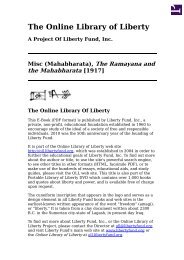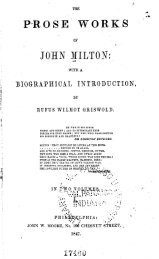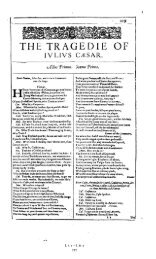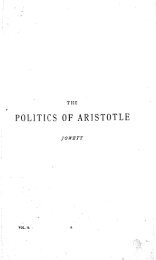- Page 1:
METHODS OF SOCIAL REFORM.
- Page 5 and 6:
PREFACE. A FEW words will explain t
- Page 7 and 8:
CONTENTS. AXUSEYEYTB OF THE PEOPLE
- Page 9 and 10:
METHODS OF SOCIAL REFORM. AMUSEJIEN
- Page 11 and 12:
AMUSEMENTS OF THE PEOPLE, 3 the mau
- Page 13 and 14:
AMUSEMENTS OF THE PEOPLE. 5 and of
- Page 15 and 16: AMUSEXENTS OF THE PEOPLE. 7 she is
- Page 17 and 18: AMUSEMENTS OF THE PEOPLE. 9 the rat
- Page 19 and 20: AMWSEMENTS OF THE PEOPLE. 1I must i
- Page 21 and 22: AMUSEMENTS OF THE PEOPLE. 13 gr-t w
- Page 23 and 24: militia band, wpeciallg the drnmmer
- Page 25 and 26: AMUSEMENTS OF THE PEOPLE. 17 pulsor
- Page 28: 20 JfETHODS OF SOCIAL REFORM. tnsto
- Page 31 and 32: of cornical adventures which befell
- Page 33 and 34: divisions of the house and the diff
- Page 35 and 36: AM USEMEdVTS OF 1‘HE PEOPLE. 27 i
- Page 37 and 38: of utility which is thereby acquire
- Page 39 and 40: THE RATl0NAL.E OF FREE PULUic LlBRA
- Page 41 and 42: THE RATIONALE OF FREE PUBLIC LtBRAR
- Page 43 and 44: THE RATlONALE OF FREE PUBLIC LIBRAR
- Page 45 and 46: THE RATlONALE OF FREE PUBLIC LIBRAR
- Page 47 and 48: THE RATIONALE OF FREE PUBLKC LIERAR
- Page 49 and 50: THE RAT'ONALE OF FREE PUBUC LZBRARl
- Page 51 and 52: THE RATIONRLE OF FREE PUBUC WBRARiE
- Page 53 and 54: THE h'A.TiOA!ALE OF FREE PUBLIC LIB
- Page 55 and 56: THE RATIONALE OF FREE PUBLIC UBRARI
- Page 57 and 58: THE RATIOIVALE OF FREE PULFLZC UBRA
- Page 59 and 60: THE RATIONALE OF FREE PUBLIC WBRARK
- Page 61 and 62: THE USE AND ABUSE OF MUSEUMS.* IT i
- Page 63 and 64: THE USE AND ABUSE UF MUSBUMS. 55 V8
- Page 65: THE USE RdVD A BUb-ii OF MUSE U1.11
- Page 69 and 70: collections. The ordinary visitor,
- Page 71 and 72: THE USE AND ABUSE OF MUSEUMS. 63 pl
- Page 73 and 74: dl tho birds shot in the neigllbonr
- Page 75 and 76: THE USE AND ABUSE OF MUSEUdfS. 457
- Page 77 and 78: TBE USE AND ABUSE OF MUSEUMS. Then,
- Page 79 and 80: muttor of course, srrange for an ex
- Page 81 and 82: TUE USE AND ABUSE OF MUSEUMS. 73 cu
- Page 83 and 84: THE USE: Ah'D ABUSE OF MUSEU.VS. 75
- Page 85 and 86: st Oxford and the Fitsmilliarn Muse
- Page 87 and 88: THE USE AND ABUSE OF MUSEUMS. 79 A
- Page 89 and 90: chaos some unity of ideas and actio
- Page 91 and 92: “ CRa4 M. 83 like having their wo
- Page 93 and 94: ‘‘ CRAM.* 83 x. exnminntion-pap
- Page 96 and 97: 88 METHODS OF SOCIAL REFORM. nfter-
- Page 98 and 99: Po METHODS OF SOCIAL REFORM examina
- Page 100: 92 METHODS OF SOCIAL REFORM. makes
- Page 103 and 104: CRAM.” 9s metho& of training, whi
- Page 105 and 106: ‘< 97 be urged in defence of tho
- Page 107 and 108: “ CRAM.” 99 upon their freedom
- Page 109 and 110: TRADES SOCIETIES THEIR OBJECTS AND
- Page 111 and 112: TRADES SOCIETfES: THEIR OBYECTS AND
- Page 113 and 114: TRADES SOCIETIES: THEIR OB3ECTS AND
- Page 115 and 116: TRADES SOZIETIES’: TIiEfR OBFECTS
- Page 117 and 118:
TRADES.SOCIETIES: THEZR OBTECTS AND
- Page 120 and 121:
112 METHODS OF SOCIAL REFORM. who w
- Page 122 and 123:
x 14 METHODS OF SOCfAL REFORhf. not
- Page 124 and 125:
I 16 hfETlODS OF SOCIAL REFORM. Bat
- Page 126 and 127:
. I r8 METHODS OF SOCIAL A‘EFORM.
- Page 128 and 129:
the advantages of becoming themselv
- Page 130 and 131:
ON INDUSTRIAL PARI’NERSHIPS.* I.
- Page 132 and 133:
124 METHODS OF SOCIAL REFORM. Some
- Page 134 and 135:
I a6 METHODS OF SOCIAL REFORM. rrnd
- Page 136 and 137:
I 28 METHODS OF SOCIAL REFORM. poin
- Page 138 and 139:
13Q METHODS OF SOCIAL REFORM. Pea00
- Page 140 and 141:
132 METHODS OF SOCIAL REFORM ' wage
- Page 142 and 143:
134 METUODS OF SOCIAL REFORM. of a
- Page 144 and 145:
136 METHODS OF SOCXAL REFORM. “(3
- Page 146 and 147:
2 38 AfETH0D.S OF SOCfAL REFORM. ma
- Page 148 and 149:
140 METHODS OF SOCIAL REFORM. The f
- Page 150 and 151:
I42 METHODS OF SOCIAL REFORM whose
- Page 152 and 153:
144 METHODS OF SOCIAL REFORM. of mi
- Page 154 and 155:
1 4 METHODS OF SOCIAL REFORM. moant
- Page 156 and 157:
For my own part I do think that the
- Page 158 and 159:
1 j0 2WETJfOD-S OF SOCIAL REFORM. p
- Page 160 and 161:
152 METHODS OF socra REFORM. profit
- Page 162 and 163:
154 JfETHQDS OF SOCIAL REFORM. work
- Page 164 and 165:
WIIILE engaged in preparing a small
- Page 166 and 167:
15s ME TIIODS UF SOCIAL REFOR‘U.
- Page 168 and 169:
160 ME7%rODS OF SOCIAL REFORM. to r
- Page 170 and 171:
162 METHODS OF SOCIALd REFORM. 1870
- Page 172 and 173:
164 METHODS OF SOCIAL REFORM. colle
- Page 174 and 175:
166 AfETNODS OF SOCIAL REFORJf. tha
- Page 176 and 177:
168 METHODS OF SOCIAL REFORM Mlljes
- Page 178 and 179:
f 70 METHUDS OF SOCIAL REFORM. AJ a
- Page 180 and 181:
173 METHODS OF SOCIAL REFORM childr
- Page 182 and 183:
J 74 METHQDS OF SOCZAL REFORM tho f
- Page 184 and 185:
176 METHODS OF SOCIAL REFORM. young
- Page 186 and 187:
378 METHODS OF SOCIAL REFORM. work
- Page 188 and 189:
INAUGURAL ADDRESS AS PRESIDEKT OF T
- Page 190 and 191:
I e2 METHODS OF SOCIAL REFORM. conc
- Page 192 and 193:
. . . 184 HETHUDS OF SOCIAL REFORM.
- Page 194 and 195:
1x1. I am glad to see that one resu
- Page 196 and 197:
188 METHODS OF SOCIAL REFORM. sensi
- Page 198 and 199:
‘90 METHODS OF SOCIAL REFORM. cam
- Page 200:
192 METIfODS OF SOCIAL REFUKJf. to
- Page 203 and 204:
BRITZSH ASSOCiAT~ON-OP~Ni~~'G ADDRE
- Page 205 and 206:
BRITISH ASSOCIA TIOW-OPENING ADDRES
- Page 207 and 208:
BRITISH ASSOCIA TIOAr-OPEAYNG ADDRE
- Page 209 and 210:
GRZTZSH ASSOCIA TZO.V-0PENING ADDRE
- Page 211 and 212:
BRITlSfZ ASSOCZA TZOA" UPEIVZ~VG AD
- Page 213 and 214:
BRlTlSH ASSOCIA TION-OPENING ADDRES
- Page 215 and 216:
BRITISH ASSOCIA TION-OPENfNG ADDRES
- Page 217 and 218:
even lower in pmportion. In fact th
- Page 219 and 220:
BRIT/SN ASSOCIA r10A'- OPEA1'laVG A
- Page 221 and 222:
BRITISH ASSOCIA TION-OPENiNG ADDRES
- Page 223 and 224:
BRITISH ASSOCIA TIOLW”PEAVZNG ADD
- Page 225 and 226:
CRUELTY TO ANIMALS-A SOCIOLOGY. * S
- Page 227 and 228:
proportionate moral sentiment is fo
- Page 229 and 230:
88 ct an abomination imported from
- Page 231 and 232:
CRUELTY TO AN2MAL.F" STUDY IN SOCIO
- Page 233 and 234:
CRUELTY TO ANIMALS-A STUDY IN SOCIO
- Page 235 and 236:
CRCTELTJ‘ TO A.WSfALS--A STUDY I.
- Page 237 and 238:
CRUELTY TO ANIMALS-A STUDY IN SOCIO
- Page 239 and 240:
amomb of pain are daily inflicted,
- Page 241 and 242:
CRUELTY 70 ANIMALS-A STUDY IN SOCIO
- Page 243 and 244:
CRUELTY TO ANJLIALS-A STUDY IN SOCI
- Page 245 and 246:
THE UNlTED KlNGDOM ALLIANCE. 239 it
- Page 247 and 248:
songht t.Lis opportunity of giving
- Page 249 and 250:
J .. . THE UNlTED KlNGDOM ALLLANCE.
- Page 251 and 252:
they *e or can ; what I objeot fo i
- Page 253 and 254:
Sorely, as regards the publicans, t
- Page 255 and 256:
THE UNITED KINGDOM ALWANCE. %? 88 b
- Page 257 and 258:
ook, that we should not spend a qwt
- Page 259 and 260:
THE UNITED KINGDOM ALLIANCE. 251 th
- Page 261 and 262:
EXPERIMENTAL LEGISLATION AND THE DR
- Page 263 and 264:
E.rpExAZfEmAL LEGISLA TION-DRfN.. T
- Page 265 and 266:
EXPERI.IfENTifL LEGISLATION. 157 an
- Page 267 and 268:
EXPERIMELVTAL LEGISLA TiO-lr. 259 m
- Page 269 and 270:
of the present day. Even styles of
- Page 271 and 272:
EXPERl-1iE~VTAL LEGISLA TICILK 263
- Page 273 and 274:
EXPERZME.VTAL LEGISLATIOA‘. 265 d
- Page 275 and 276:
Some years since the Howard Associa
- Page 277 and 278:
EXPERIMENTAL LEGZSLATZOiV. 269 hd a
- Page 279 and 280:
The kst way of dealing with tho liq
- Page 281 and 282:
EXPERIMENTAL LEGISLA TION. 173 sche
- Page 283 and 284:
EXPERIMENTAL LEGZSU TION. 275 tried
- Page 285 and 286:
ON THE ANALOGY BETWEEN THE POST OFF
- Page 287 and 288:
ON GO YERXMENT CONTROL OF TELEGRAPH
- Page 289 and 290:
08 GOVERNiWENT CONTROL OF TELEGRAPH
- Page 291 and 292:
ON GOVERA'MENP CONTROL OF TELEGRAPH
- Page 293 and 294:
ON GOVERNMENT CONTROL OF TELEGRAPHS
- Page 295 and 296:
0,tr GOVERA'A~EJVT COLV~~ROL OF TEL
- Page 297 and 298:
ON GQVERN.lfEA\'T COA'TROL OF TELEG
- Page 299 and 300:
parcel incurs 6 new, uncertain, and
- Page 301 and 302:
THE POST OFFICE TELEGRAPHS AND THEI
- Page 303 and 304:
THE POST OFFICE TELEGRAPHS. 29s reo
- Page 305 and 306:
THE POST OFFICE TELEGR.4PIf.F. 297
- Page 307 and 308:
TffE POST OFFlCE TELEGRAPIiS. 299 s
- Page 309 and 310:
THE POST OFFlCE TELGGRAPRS. 30 1 te
- Page 311 and 312:
man might espect to makc money by s
- Page 313 and 314:
THE POST OFFZCE TELEGRAPHS. 305 ind
- Page 315 and 316:
POSTAL NOTES, MONEY ORDERS, AND BAN
- Page 317 and 318:
POSTAL KOTES. -$fU*\’EY ORDERS, B
- Page 319 and 320:
POSTAL NOTES, MONEY ORDERS, BANK CH
- Page 321 and 322:
P0ST:IL ,lV0TES, .VOsl’El- ORDERS
- Page 323 and 324:
able to bearer--a simple cnde lrtmt
- Page 325 and 326:
POSTAL NOTES, MOAVEY ORDERS, BANK C
- Page 327 and 328:
POSTAL NOTES, MO.YEY ORDERS, BALVK
- Page 329 and 330:
POSTAL LI'OTES, AtO,%'EY ORDERS, BA
- Page 332 and 333:
. STATE PARCEL POST. ’‘ AT n se
- Page 334 and 335:
326 METHODS OE SOCIAL REFORM. Apin,
- Page 336 and 337:
328 METHODS i'b? SOCIAL REFORM. deg
- Page 338 and 339:
330 METHODS OF SOCIAL REFORM. altho
- Page 340 and 341:
may mean. But thoy seldom charge le
- Page 342 and 343:
334 ,I/ETHODS OF SOCIAL REFORJI. of
- Page 344 and 345:
336 METHODS OF SOClAL REFORM. possi
- Page 346 and 347:
338 METHODS OF SOCIAL REFORM. Offic
- Page 348 and 349:
34 hfE TIiODS OF SOCIAL REFORM. ins
- Page 350 and 351:
342 AfETHODS OF SOCIAL REFORM. bo s
- Page 352 and 353:
354 METHODS Oie- SOCLAL REFORM. It
- Page 354 and 355:
34.6 METHODS OF SOCIAL REFORM. inst
- Page 356 and 357:
348 METIIODS OF SOCIAL REFORM be =s
- Page 358 and 359:
350 dI
- Page 360 and 361:
352 ME7HODS OF SOCIAL REFORM. wonde
- Page 362 and 363:
354 r3IETl(ORS OF SOCfAL REFORM. di
- Page 364 and 365:
almost perfoctlp fulfilled in the p
- Page 366 and 367:
358 dfETH0D.S OF SOCIAL REFORM. was
- Page 368 and 369:
360 METHODS OF SOCTAL REFORM. at tw
- Page 370 and 371:
362 METHODS OF SOCfdL REFORM of rai
- Page 372 and 373:
364 itfET'€OD.S OF SOClAL REFORM.
- Page 374 and 375:
366 METHODS OF SOCfAL REFURM. from
- Page 376 and 377:
368 HETlfODS OF SOCIAL REFORM. many
- Page 378 and 379:
370 METHODS OF SOCIAL REFORM. lose
- Page 380 and 381:
37 2 ME THO DS o F sou-4 L REFORM.
- Page 382 and 383:
374 METHODS OF SOCIAL KEFORJf. expe
- Page 384 and 385:
expcnditurc. 376 A16 77iOUJ' i 1" S
- Page 386 and 387:
378 METHODS OF SOCIAL REFORM. the C
- Page 389 and 390:
THE RAIL 1 li4 JY1T A-171 TIfE S T.
- Page 391:
THE RAIL JVA YS A.VD THE STATE. 383
















